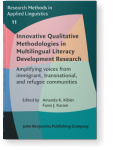Chapter 12
Critical collaborative autoethnography
This chapter explores the transformative potential that
applying critical collaborative autoethnography can have in the path
towards decolonizing academic writing, a particular type of literacy
practice. Traditional research methodologies, both quantitative and
qualitative, are critiqued for marginalizing non-Western
perspectives. We propose a paradigm shift towards decolonizing
methodologies, foregrounding our own positionality as multilingual
researchers navigating the complexities of academic publishing. We
re-introduce the concept of critical friend as a
unique method for conducting autoethnographies. Thus, we advocate
the use of critical collaborative autoethnography
to foster collective exploration of research subjectivity and
power-sharing among researcher-participants. This approach moves us
beyond simply acknowledging positionality to embracing of
relationality in research, advocating for more collaborative
inclusive research and multilingual literacy practices in
academia.
Article outline
- Introduction
- Overview of the study and its findings
- Literature review
- Methodology
- Findings and discussion
- Methodological discussion: Positionality for more equitable
research
- Methodological innovations
- Focusing on equity
- Implications for qualitative research on multilingual literacy
development
-
References
This content is being prepared for publication; it may be subject to changes.
